麦克马斯特大学经济与计算机科学本科专业
- 格式:pdf
- 大小:195.91 KB
- 文档页数:12
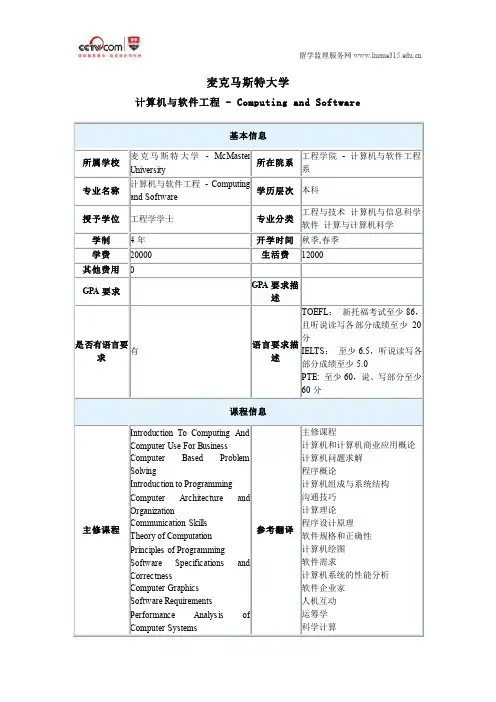
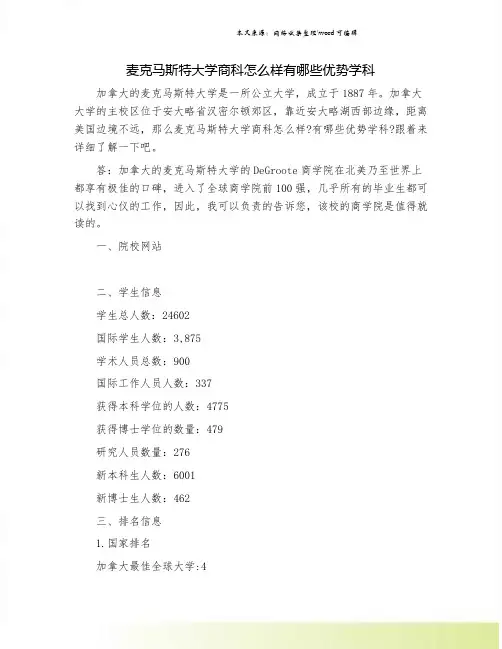
麦克马斯特大学商科怎么样有哪些优势学科加拿大的麦克马斯特大学是一所公立大学,成立于1887年。
加拿大大学的主校区位于安大略省汉密尔顿郊区,靠近安大略湖西部边缘,距离美国边境不远,那么麦克马斯特大学商科怎么样?有哪些优势学科?跟着来详细了解一下吧。
答:加拿大的麦克马斯特大学的DeGroote商学院在北美乃至世界上都享有极佳的口碑,进入了全球商学院前100强,几乎所有的毕业生都可以找到心仪的工作,因此,我可以负责的告诉您,该校的商学院是值得就读的。
一、院校网站二、学生信息学生总人数:24602国际学生人数:3,875学术人员总数:900国际工作人员人数:337获得本科学位的人数:4775获得博士学位的数量:479研究人员数量:276新本科生人数:6001新博士生人数:462三、排名信息1.国家排名加拿大最佳全球大学:42.学科排名生物学和生物化学:并列165化学:并列310临床医学:34工程:256环境/生态学:315免疫学:并列101材料科学:并列221数学:104微生物学:165分子生物学与遗传学:191神经科学和行为:188物理:并列543植物与动物科学:并列347精神病学/心理学:并列122社会科学与公共卫生:并列102空间科学:并列179四、其他信息其他校区位于伯灵顿市汉密尔顿市中心,基奇纳滑铁卢市和尼亚加拉市。
该大学的国际学生来自超过75个国家,其全职教师超55人。
非加拿大学生的学费较高。
大学经营的学生宿舍可供选择,包括主题生活社区,如全女性社区,健康的活跃生活社区和全球视角社区。
该大学有六个主要的学术部门,工程、健康科学、人文科学、科学、社会科学和DeGroote商学院、主要的教学语言是英语。
麦克马斯特大学还开设了一个艺术和科学课程,每年招收约60名学生,并提供更多跨学科的本科生经历。
麦克马斯特大学本科生的学术日程以学期为基础,包括可选的春/夏学期。
研究生水平的学术日历有三个学期:秋季、冬季和夏季。
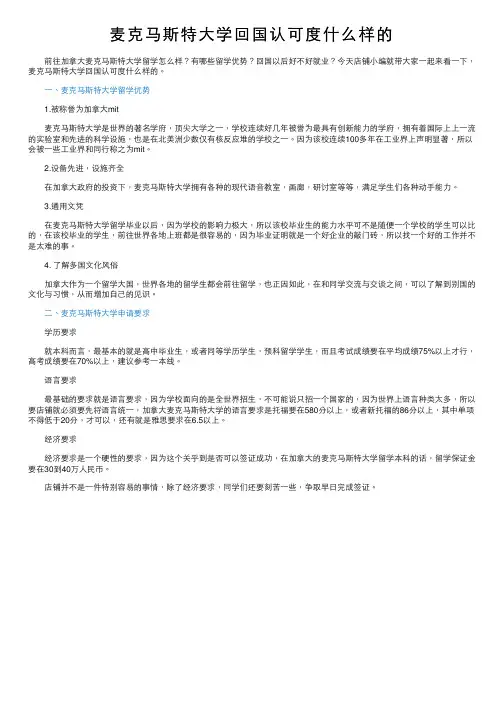
⻨克⻢斯特⼤学回国认可度什么样的 前往加拿⼤⻨克⻢斯特⼤学留学怎么样?有哪些留学优势?回国以后好不好就业?今天店铺⼩编就带⼤家⼀起来看⼀下,⻨克⻢斯特⼤学回国认可度什么样的。
⼀、⻨克⻢斯特⼤学留学优势 1.被称誉为加拿⼤mit ⻨克⻢斯特⼤学是世界的著名学府,顶尖⼤学之⼀,学校连续好⼏年被誉为最具有创新能⼒的学府,拥有着国际上上⼀流的实验室和先进的科学设施,也是在北美洲少数仅有核反应堆的学校之⼀。
因为该校连续100多年在⼯业界上声明显著,所以会被⼀些⼯业界和同⾏称之为mit。
2.设备先进,设施⻬全 在加拿⼤政府的投资下,⻨克⻢斯特⼤学拥有各种的现代语⾳教室,画廊,研讨室等等,满⾜学⽣们各种动⼿能⼒。
3.通⽤⽂凭 在⻨克⻢斯特⼤学留学毕业以后,因为学校的影响⼒极⼤,所以该校毕业⽣的能⼒⽔平可不是随便⼀个学校的学⽣可以⽐的,在该校毕业的学⽣,前往世界各地上班都是很容易的,因为毕业证明就是⼀个好企业的敲⻔砖,所以找⼀个好的⼯作并不是太难的事。
4. 了解多国⽂化⻛俗 加拿⼤作为⼀个留学⼤国,世界各地的留学⽣都会前往留学,也正因如此,在和同学交流与交谈之间,可以了解到别国的⽂化与习惯,从⽽增加⾃⼰的⻅识。
⼆、⻨克⻢斯特⼤学申请要求 学历要求 就本科⽽⾔,最基本的就是⾼中毕业⽣,或者同等学历学⽣,预科留学学⽣,⽽且考试成绩要在平均成绩75%以上才⾏,⾼考成绩要在70%以上,建议参考⼀本线。
语⾔要求 最基础的要求就是语⾔要求,因为学校⾯向的是全世界招⽣,不可能说只招⼀个国家的,因为世界上语⾔种类太多,所以要店铺就必须要先将语⾔统⼀,加拿⼤⻨克⻢斯特⼤学的语⾔要求是托福要在580分以上,或者新托福的86分以上,其中单项不得低于20分,才可以,还有就是雅思要求在6.5以上。
经济要求 经济要求是⼀个硬性的要求,因为这个关乎到是否可以签证成功,在加拿⼤的⻨克⻢斯特⼤学留学本科的话,留学保证⾦要在30到40万⼈⺠币。
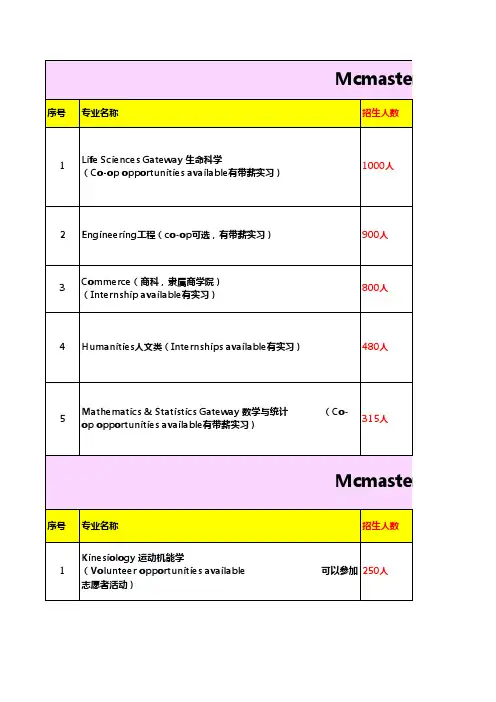
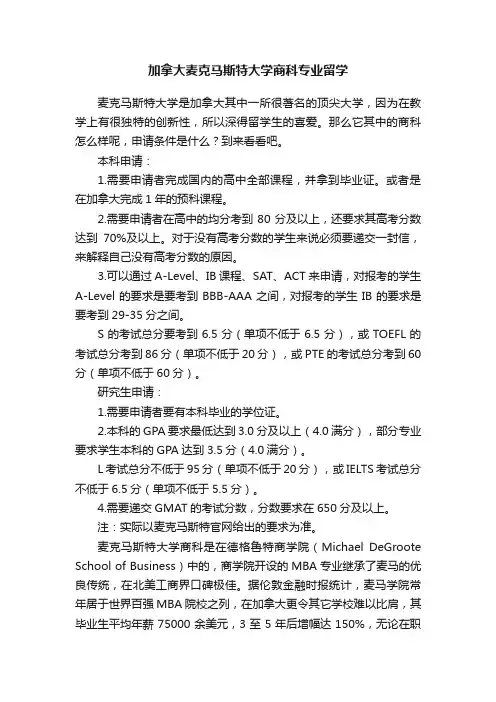
加拿大麦克马斯特大学商科专业留学麦克马斯特大学是加拿大其中一所很著名的顶尖大学,因为在教学上有很独特的创新性,所以深得留学生的喜爱。
那么它其中的商科怎么样呢,申请条件是什么?到来看看吧。
本科申请:1.需要申请者完成国内的高中全部课程,并拿到毕业证。
或者是在加拿大完成1年的预科课程。
2.需要申请者在高中的均分考到80分及以上,还要求其高考分数达到70%及以上。
对于没有高考分数的学生来说必须要递交一封信,来解释自己没有高考分数的原因。
3.可以通过A-Level、IB课程、SAT、ACT来申请,对报考的学生A-Level的要求是要考到BBB-AAA之间,对报考的学生IB的要求是要考到29-35分之间。
S的考试总分要考到6.5分(单项不低于6.5分),或TOEFL的考试总分考到86分(单项不低于20分),或PTE的考试总分考到60分(单项不低于60分)。
研究生申请:1.需要申请者要有本科毕业的学位证。
2.本科的GPA要求最低达到3.0分及以上(4.0满分),部分专业要求学生本科的GPA达到3.5分(4.0满分)。
L考试总分不低于95分(单项不低于20分),或IELTS考试总分不低于6.5分(单项不低于5.5分)。
4.需要递交GMAT的考试分数,分数要求在650分及以上。
注:实际以麦克马斯特官网给出的要求为准。
麦克马斯特大学商科是在德格鲁特商学院(Michael DeGroote School of Business)中的,商学院开设的MBA专业继承了麦马的优良传统,在北美工商界口碑极佳。
据伦敦金融时报统计,麦马学院常年居于世界百强MBA院校之列,在加拿大更令其它学校难以比肩,其毕业生平均年薪75000余美元,3至5年后增幅达150%,无论在职位和业绩成就上都令业界瞩目。
其商学院的MBA课程被金融时报评为世界100家最著名MBA学院之一。
随着不断发展,2013年最新增添了金融硕士项目,完善了其商科体制。
成为加拿大为数不多提供金融硕士的著名商学院之一。
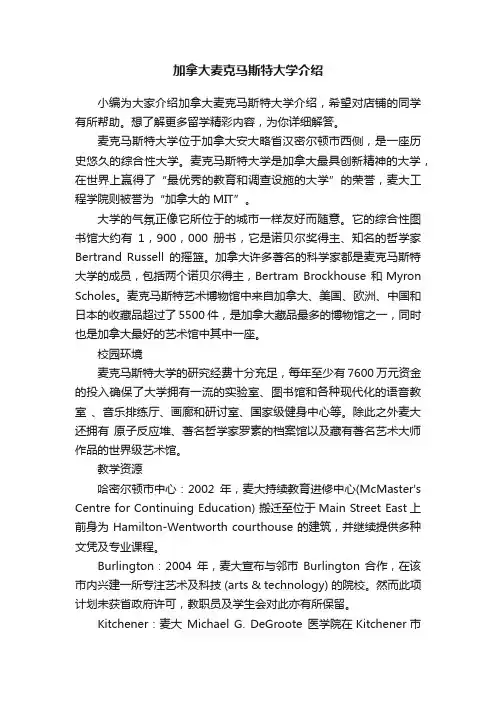
加拿大麦克马斯特大学介绍小编为大家介绍加拿大麦克马斯特大学介绍,希望对店铺的同学有所帮助。
想了解更多留学精彩内容,为你详细解答。
麦克马斯特大学位于加拿大安大略省汉密尔顿市西侧,是一座历史悠久的综合性大学。
麦克马斯特大学是加拿大最具创新精神的大学,在世界上赢得了“最优秀的教育和调查设施的大学”的荣誉,麦大工程学院则被誉为“加拿大的MIT”。
大学的气氛正像它所位于的城市一样友好而随意。
它的综合性图书馆大约有1,900,000册书,它是诺贝尔奖得主、知名的哲学家Bertrand Russell的摇篮。
加拿大许多著名的科学家都是麦克马斯特大学的成员,包括两个诺贝尔得主,Bertram Brockhouse 和Myron Scholes。
麦克马斯特艺术博物馆中来自加拿大、美国、欧洲、中国和日本的收藏品超过了5500件,是加拿大藏品最多的博物馆之一,同时也是加拿大最好的艺术馆中其中一座。
校园环境麦克马斯特大学的研究经费十分充足,每年至少有7600万元资金的投入确保了大学拥有一流的实验室、图书馆和各种现代化的语音教室、音乐排练厅、画廊和研讨室、国家级健身中心等。
除此之外麦大还拥有原子反应堆、著名哲学家罗素的档案馆以及藏有著名艺术大师作品的世界级艺术馆。
教学资源哈密尔顿市中心:2002年,麦大持续教育进修中心(McMaster's Centre for Continuing Education) 搬迁至位于Main Street East上前身为 Hamilton-Wentworth courthouse 的建筑,并继续提供多种文凭及专业课程。
Burlington:2004年,麦大宣布与邻市Burlington 合作,在该市内兴建一所专注艺术及科技 (arts & technology) 的院校。
然而此项计划未获省政府许可,教职员及学生会对此亦有所保留。
Kitchener:麦大Michael G. DeGroote 医学院在Kitchener市扩建,新校舍将会于滑铁卢大学 (University of Waterloo) 共用。
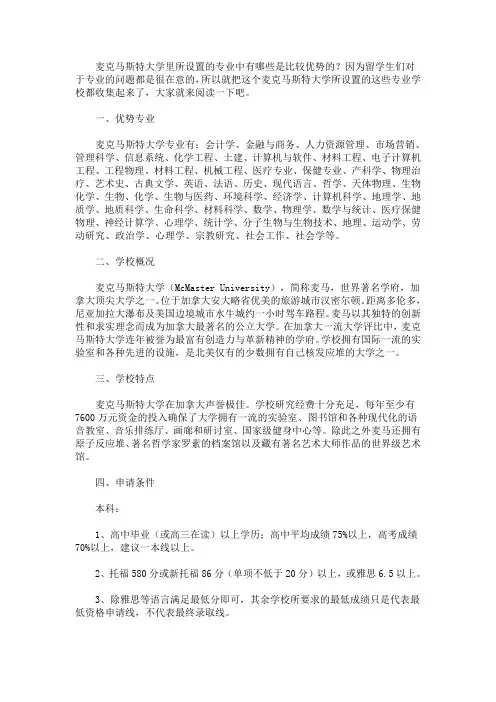
麦克马斯特大学里所设置的专业中有哪些是比较优势的?因为留学生们对于专业的问题都是很在意的,所以就把这个麦克马斯特大学所设置的这些专业学校都收集起来了,大家就来阅读一下吧。
一、优势专业麦克马斯特大学专业有:会计学、金融与商务、人力资源管理、市场营销、管理科学、信息系统、化学工程、土建、计算机与软件、材料工程、电子计算机工程、工程物理、材料工程、机械工程、医疗专业、保健专业、产科学、物理治疗、艺术史、古典文学、英语、法语、历史、现代语言、哲学、天体物理、生物化学、生物、化学、生物与医药、环境科学、经济学、计算机科学、地理学、地质学、地质科学、生命科学、材料科学、数学、物理学、数学与统计、医疗保健物理、神经计算学、心理学、统计学、分子生物与生物技术、地理、运动学、劳动研究、政治学、心理学、宗教研究、社会工作、社会学等。
二、学校概况麦克马斯特大学(McMaster University),简称麦马,世界著名学府,加拿大顶尖大学之一。
位于加拿大安大略省优美的旅游城市汉密尔顿。
距离多伦多,尼亚加拉大瀑布及美国边境城市水牛城约一小时驾车路程。
麦马以其独特的创新性和求实理念而成为加拿大最著名的公立大学。
在加拿大一流大学评比中,麦克马斯特大学连年被誉为最富有创造力与革新精神的学府。
学校拥有国际一流的实验室和各种先进的设施,是北美仅有的少数拥有自己核发应堆的大学之一。
三、学校特点麦克马斯特大学在加拿大声誉极佳。
学校研究经费十分充足,每年至少有7600万元资金的投入确保了大学拥有一流的实验室、图书馆和各种现代化的语音教室、音乐排练厅、画廊和研讨室、国家级健身中心等。
除此之外麦马还拥有原子反应堆、著名哲学家罗素的档案馆以及藏有著名艺术大师作品的世界级艺术馆。
四、申请条件本科:1、高中毕业(或高三在读)以上学历;高中平均成绩75%以上,高考成绩70%以上,建议一本线以上。
2、托福580分或新托福86分(单项不低于20分)以上,或雅思6.5以上。

加拿大麦克马斯特大学专业设置:本科课程专业立思辰留学360了解,自动化与交通工具技术、生物科技、自动控制、计算机科学、工程学、健康科学、人类学、运动机能学、助产学、音乐、护理、环境与地球科学、综合科学、生命科学、数学与统计学、物理科学、社会科学、DeGroote商学院(会计、金融、人类资源、信息系统、国际商务、市场营销)麦克马斯特大学和莫哈克学院合作项目-——理科学士项目:四年制的学士学位课程,其专业:汽车与交通工具技术专业AutomotiveandVehicleTechnology、生物科技专业Biotechnology、工艺自动化专业ProcessAutomation硕士课程专业人类学、生物化学、生物学、生物医学工程、MBA、化学生物学、化学工程、化学、土木工程、著作学、认知科学、传媒、传媒管理、计算机工程与科学、计算机科学、文化研究与批判理论、地球与环境科学、经济学、健康科学、电子与计算机工程、工程设计、工程革新、工程物理学、英语、法语、地理学、健康与年龄、健康与放射物理、历史、运动机能学、制造工程、材料工程、数学、机械工程、医学、神经系统科学、护理、物理理疗、国际关系学、物理与天文学、心理学、放射科学、复原科学、社会学、软件工程、软件工程与病毒系统、统计学、核工程。
麦克马斯特大学大学优势1.商学在北美排名前列,德格鲁特商学院为北美前50、世界前100强商学院之一;2.世界大学学术排名第92位,加拿大第四(2013);泰晤士高等教育世界大学排名第92位,加拿大第四(2013-2014);QS世界大学排名第140位,加拿大第六(2013);并在其他排名中,稳距加拿大前五;3.是英联邦国家中第一个拥有研究用核子反应堆的学校,麦马核反应堆(McMasterNuclearReactor)是加拿大所有大学中唯一一个中等流量(medium-flux)的核反应堆;4.科研经费十分充足,每年至少7600万的资金投入确保了学校拥有一流的实验室和各种先进的设施;5.图书馆藏书超200万册,订有14,000种期刊,同时该馆藏有大量18世纪文献;6.各种现代化的语音教室、音乐排练厅、画廊和研讨室都有着现代化的装置;7.在科学工程方面,拥有核发生器、VDG加速器等高精尖设备;8.网络主干、终端和微机将校园连成一个有机的网络体系;9.其医学院在世界排名第14,加拿大第一(泰晤士高等教育世界大学排名2012-2013)。
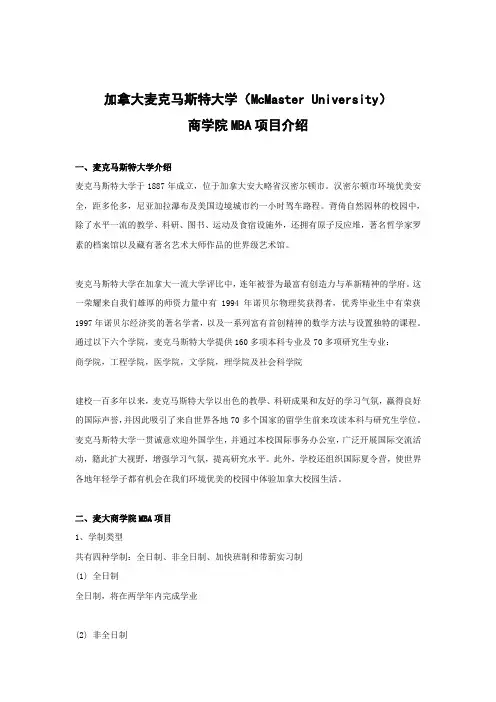
加拿大麦克马斯特大学(McMaster University)商学院MBA项目介绍一、麦克马斯特大学介绍麦克马斯特大学于1887年成立,位于加拿大安大略省汉密尔顿市。
汉密尔顿市环境优美安全,距多伦多,尼亚加拉瀑布及美国边境城市约一小时驾车路程。
背倚自然园林的校园中,除了水平一流的教学、科研、图书、运动及食宿设施外,还拥有原子反应堆,著名哲学家罗素的档案馆以及藏有著名艺术大师作品的世界级艺术馆。
麦克马斯特大学在加拿大一流大学评比中,连年被誉为最富有创造力与革新精神的学府。
这一荣耀来自我们雄厚的师资力量中有1994年诺贝尔物理奖获得者,优秀毕业生中有荣获1997年诺贝尔经济奖的著名学者,以及一系列富有首创精神的数学方法与设置独特的课程。
通过以下六个学院,麦克马斯特大学提供160多项本科专业及70多项研究生专业:商学院,工程学院,医学院,文学院,理学院及社会科学院建校一百多年以来,麦克马斯特大学以出色的教學、科研成果和友好的学习气氛,赢得良好的国际声誉,并因此吸引了来自世界各地70多个国家的留学生前来攻读本科与研究生学位。
麦克马斯特大学一贯诚意欢迎外国学生,并通过本校国际事务办公室,广泛开展国际交流活动,籍此扩大视野,增强学习气氛,提高研究水平。
此外,学校还组织国际夏令营,使世界各地年轻学子都有机会在我们环境优美的校园中体验加拿大校园生活。
二、麦大商学院MBA项目1、学制类型共有四种学制:全日制、非全日制、加快班制和带薪实习制(1) 全日制全日制,将在两学年内完成学业(2) 非全日制非全日制,上课时间主要集中在晚上(不适宜外国学生参加)(3) 加快班制(八个月完成学业)主要针对毕业于商科,荣誉商科或者麦大工程学与管理学的本科生且毕业时间不超过五年。
申请者可直接进入加快班全日制或非全日制第二年学习,第一学年学分均视为修得满分。
毕业于中国的本科生,学业优秀,也可以申请。
(4) 带薪实习制学生将在28个月内分四个学期完成学业,其中穿插三次连续四个月的实习时间。

中外合作办学2+2国际本科可以选择哪些专业?各个学校的中外合作办学2+2国际本科举办的专业各不相同。
乐昇学教育整理了一下,大致分为以下大类的专业。
一、商科方向会计学、审计学、金融会计、商务管理、财务管理、公共管理、企业管理、酒店管理、应用链管理、人力资源管理、国际金融管理、商业数据分析、市场营销等二、工科方向国际信息工程、人工智能、计算机程序设计、软件工程、网络工程、网络与信息技术、软件工程、信息科学、人工智能、网络安全、大数据、土木工程、电子工程及其自动化、机械工程、机械电子工程、测控技术与仪器、机电一体化、飞行器设计等三、法学方向国际法、公司法、商业法等四、音乐方向音乐制作、音乐表演、音乐与科技、音乐教育、流行音乐、音乐管理、艺术管理等五、影视制作方向影视表演、影视编剧、影视表演、电影制作、3D制作、影视造型设计、视觉媒体声音设计等六、新闻与传播方向新闻学、媒体与新闻学、广播新闻学、运动新闻学、传媒学、大众传媒、媒体与出版、时尚新闻学等七、数字媒体方向数字媒体传播、动漫与数字媒体艺术、摄影、数字艺术设计、电影与电视制作、平面设计、3D建模等八、艺术设计方向产品设计、视觉传达设计、服装设计、数字交互与体验设计、游戏设计、产品设计、环境设计、动漫设计、工业设计、字体设计等以上就是“中外合作办学2+2国际本科可以选择哪些专业?”的全部内容。
更多相关信息,敬请联系乐昇学教育小乐老师。
考生可以根据自己的分数和自己中意的学校和专业进行志愿填报,也可以考虑计划外的招生。
这些项目是不占用计划内的志愿填报名额的,如部分学校的4+0项目、2+2项目、1+3项目、3+1项目、3+2本硕连读项目、2+2+1本硕连读项目等。
如果英语比较好的话,可以考虑4+0项目,不用出国,就可以拿到国外的国际本科,且可以留服认证。
如果想要本科硕士一起读的话,可以选择3+2或者3+1+1或者1+3+1等形式。
如果考试成绩不是很理想,又想读国际本科的可以选择2+2或者是1+3以及国外留学,当然也可以选择边工作边读书的非全日制的学历提升其他方式,如自学考试、成人高考、国家开放大学等。
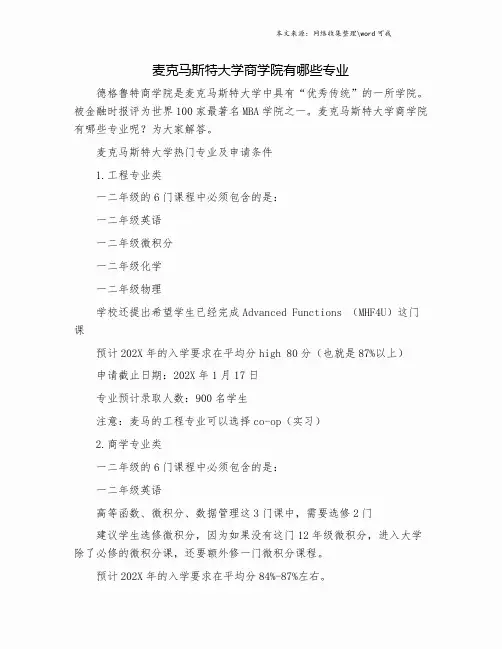
麦克马斯特大学商学院有哪些专业德格鲁特商学院是麦克马斯特大学中具有“优秀传统”的一所学院。
被金融时报评为世界100家最著名MBA学院之一。
麦克马斯特大学商学院有哪些专业呢?为大家解答。
麦克马斯特大学热门专业及申请条件1.工程专业类一二年级的6门课程中必须包含的是:一二年级英语一二年级微积分一二年级化学一二年级物理学校还提出希望学生已经完成Advanced Functions (MHF4U)这门课预计202X年的入学要求在平均分high 80分(也就是87%以上)申请截止日期:202X年1月17日专业预计录取人数:900名学生注意:麦马的工程专业可以选择co-op(实习)2.商学专业类一二年级的6门课程中必须包含的是:一二年级英语高等函数、微积分、数据管理这3门课中,需要选修2门建议学生选修微积分,因为如果没有这门12年级微积分,进入大学除了必修的微积分课,还要额外修一门微积分课程。
预计202X年的入学要求在平均分84%-87%左右。
申请截止时间:202X年1月17日专业预计录取人数:800名学生3.生命科学专业类一二年级的6门课程中必须包含的是:一二年级英语一二年级高等函数或者微积分,其中选一个一二年级生物一二年级高等函数、微积分、化学、物理其中选一个注意:学校推荐修微积分课程预计202X年的入学要求在平均分85%-88%申请截止日期:202X年1月17日专业预计录取人数:1000名学生4.计算机科学专业类一二年级的6门课程中必须包含的是:一二年级英语一二年级微积分一二年级生物、化学、物理、空间科学、计算机科学、计算机技术,其中选两门预计202X年的入学要求在平均分90%-95%。
申请截止日期:202X年1月17日专业预计录取人数:50名学生麦克马斯特大学MBA项目麦克马斯特大学作为加拿大的顶尖级学府之一,因其古老的学术积淀和高质量的教育水平而闻名于世。
麦大商学院(Michael DeGrooteSchool of Business)开设的MBA专业继承了麦大的优良传统,在北美工商界口碑极佳。
【导语】麦马拥有在加拿⼤能与麦吉尔⼤学相媲美的医学院,以及⼀流的商学院。
其⼯程学院更是在全北美名列前茅,位列加拿⼤六⼤之⼀。
由于麦克马斯特⼤学⼀百多年来在⼯业界声名卓著,经常被美国同⾏和⼯业界称作“加拿⼤的MIT”。
下⾯随看看具体介绍。
优势学院及专业介绍: 1、⼯程学院 A.⼯程学院分为7个学科系:化学⼯程、⼟⽊⼯程、计算机与软件、电⼦与计算机⼯程、⼯程物理学、材料科学与⼯程、机械⼯程;提供13个本科专业。
B.均提供Co-op项⽬,即带薪实习项⽬,学⽣可在暑假期间、或者⼤三结束之后的16个⽉期间,完成8-16个⽉的实习,薪⾦由政府和该实习公司共同提供。
C.研究⽣院设有:⽣物医学⼯程学院、计算⼯程与科学学院和WalterG.Booth⼯程实践学院。
提供研究⽣、博⼠等学位课程。
2、商学院 A.商学院提供从商学本科、MBA以及商学博⼠完善的专业课程。
B.学院优势: a)AACSBAccredited(AACSB认证) b)CommerceInternshipProgram商科专业设有带薪实习项⽬,平均实习⽉薪为$3,329加币,⽉薪合约16645元⼈民币。
c)ProfessionalDesignations获得以下职业认证 oCertifiedProfessionalAccountant(CPA)注册会计师认证 oCertifiedHumanResourcesProfessional(CHRP)注册⼈⼒资源管理认证 oCertificateinBusinessTechnologyManagement(BTM)商业技术管理认证 2019年本科申请要求: 中国国内⾼中⽣:提供⾼考、会考成绩 加拿⼤本地⾼中⽣:AtleastsixGrade12U/Mlevelcourses提供⾄少六门12年级U/M的课程 直录雅思:6.5(⼩分6.0)或者托福86(⼩分20) 申请时间:2018年9⽉(具体⽇期以学校通知为准) 双录取语⾔项⽬介绍 项⽬名称:麦克马斯特⼤学的语⾔班(MELD)全称为McMasterEnglishLanguageDevelopmentDiploma。
麦马理学院开设哪些本科专业2022最新介绍麦克马斯特大学的理学院是加拿大最大的学院之一,是加拿大最著名的公立大学之一,那么麦克马斯特大学的理学院开设了哪些本科专业大家有所了解吗?下面跟着小编一起来看看吧!生物化学与生物医学生物学化学及化学生物学地球、环境与社会生命科学数学与统计学物理学和天文学心理学、神经科学与行为学Level I 入门专业课程如果你不确定自己对理学院的哪个专业感兴趣,仍无法决定就读哪个专业,可以先从理学院以下4个Level I 入门专业课程中选择其一开启自己的大学生涯:化学及物理科学环境与地球科学生命科学数学与统计学Level II 专业课程生物化学和生物医学生物化学和生物医学系(Biochemistry and Biomedical Sciences)以杰出的研究和教育而闻名,专注于研究生物体内及其相关的化学反应过程。
生物化学是一门研究生命的化学和分子基础的学科,试图从分子的角度描述和理解生命物质的结构、功能和组织。
学生在成功完成Level I 入门专业课程的学习后,将可以选择自己感兴趣的Level II专业课程继续自己的学业,从而获得学士学位。
目前,麦马理学院8个系共设有39个Level II专业,下面我们就为大家介绍一下理学院的“八大系”以及各个系所开设的Level II专业吧:生物化学和生物医学现在开设了以下Level II专业:生物化学和生物医学系的毕业生可以在免疫学、营养科学、生物信息科学、生物医学工程、基因治疗、毒理学、病理学、药理学等领域从事相关工作。
生物化学荣誉学士生命科学学士数学与统计学理学院的数学与统计学系(Mathematics & Statistics)规模较大,现有正规教师34人,博士后18人,研究生100余人。
我们在代数与数论、分析、应用数学、金融数学、几何与拓扑、数学生物学、数理逻辑、概率与统计等方面有较强的研究实力。
每周举办的研讨会都会吸引一批世界上最杰出的数学家。
加拿大麦克马斯特大学会计专业课程及费用简介
university of mcmaster 麦克马斯特大学
专业课程特点:
1、商学院世界排名88
2、师资博士生比例为全加拿大最高
3、历史悠久
4、在加拿大一流大学评比中,连年被誉为最富有创造力与革新精神的学府
5、学习管理会计与财务会计
课程入学时间:1、9月
入学要求:
1、高中毕业,参考高中会考及高考
2、ielts6.5,toefl-机试237/580笔试,总分86,每一项不低于20
3、被本校认可大学在读生可转学分,大学成绩
4、被本校认可大学本科毕业生可修第二学位,大学成绩,大学毕业证,学士学位证
费用:
申请费60加币
学费14400加币/年。
Computer Engineering ResearchDigital and computer engineering research within the ECE department covers a wide range of interests including software engineering, computing theory, parallel computing, artificial intelligence and expert systems, computer architecture and hardware, computer vision and computer communication networks. In many instances, there is strong interaction with other research groups and the Department of Computing and Software as well as participation in federal and provincial centres of excellence.The Computer-Aided Design and Test Research Group (CADT) studies issues related to the design automation and validation of embedded computing systems. The innovative hardware structures and architectures integrated with pertinent software algorithms and methodologies aim to reduce the design productivity gap caused by the very rapid increase in the complexity of modern systems-on-a-chip (SOC). The investigated techniques enable the efficient implementation of reliable hardware and software systems for data and signal processing, fault tolerant and safety critical real-time computing, infrastructure for virtual private networks, multimedia interfaces and other embedded information appliances.The Simulation Optimization Systems (SOS) Research Laboratory is carrying out research in computer-aided engineering of systems, networks and high-frequency and microwave integrated circuits. It is strongly computer-oriented and over the past decade, has received substantial support through various strategic and equipment grants as well as through industrial interaction. General topics of interest include efficient algorithms for linear and nonlinear programming, circuit simulation, device modeling, parameter extraction, sensitivity analysis, nonlinear programming, minimax approximation, worst-case design, yield estimation and optimization, sparse matrix techniques, hierarchical decomposition for very large systems, optimization system design and artificial intelligence in statistical optimization systems. Modeling and optimization are applied to large complex systems as encountered in GaAs microwave and millimetre-wave monolithic integrated circuits, microwave filters and multiplexers and the solution of field problems for active devices and microstrip structures. In all areas, excellent interaction with industry is fostered and encouraged.Please send all inquiries about our Graduate Studies Programme (application forms, information, course offerings, etc.) to our Graduate Studies SecretaryCad / Optimization / Simulation ResearchComputer-Aided Design and Test Research Group (CADT)The Computer-Aided Design and Test Research Group (CADT) studies issues related to the design automation and validation of embedded computing systems.The innovative hardware structures and architectures integrated with pertinent software algorithms and methodologies aim to reduce the design productivity gap caused by the very rapid increase in the complexity of modern systems-on-a-chip (SOC). The investigated techniques enable the efficient implementation, verification and manufacturing test of reliable hardware and software systems for data and signal processing, fault tolerant and safety critical real-time computing, infrastructure for virtual private networks, multimedia interfaces and other embedded information appliances.More information on CADT at McMaster can be found herehttp://www.ece.mcmaster.ca/~nicola/cadt.htmlSimulation Optimization Systems (SOS) Research LaboratoryThe Simulation Optimization Systems (SOS) Research Laboratory is working on some exciting projects related to CAD/CAE of electronic devices and circuits. We focus on applications in the high speed, RF, wireless, VLSI and microwave areas such as modeling and design of active and passive components and circuits.Engineers have been using optimization techniques for device, component and system modeling and CAD for decades. One of the frontiers that remain is the successful application of optimization procedures in problems for which direct application of traditional optimization approaches is not practical. The recent exploitation of iteratively refined surrogates of "fine," accurate or high-fidelity models, and the implementation of Space Mapping and related methodologies are attempts to address this issue.We have discovered and are developing novel concepts such as Space Mapping technology, including the Aggressive Space Mapping approach to engineering design optimization and Generalized Space Mapping for engineering device modeling.Space Mapping links models of different complexities, e.g., expensive full-wave EM simulations and fast, empirical circuit-theory based simulations, to accelerate iterative design optimization of engineering structures, e.g., waveguide components and microstrip circuits. It is a simple CAD methodology, which closely follows the traditional experience and intuition of engineers, yet appears to be amenable to rigorous mathematical treatment. The exploitation of properly managed "space mapped" surrogates promises significant efficiency in engineering design.In the new Implicit Space Mapping (ISM) concept we allow preassigned parameters, not used in optimization, to change in some components of the coarse model.We have forged links between Space Mapping technology and artificial neural network (ANN) technology for device modeling and circuit optimization.Dr. John W. Bandler leads the group.Please contact bandler@mcmaster.ca.Please also see http://www.sos.mcmaster.caComputer Network ResearchThe computer networks research group conducts a variety of leading-edge research in key areas relating to wireless and wireline communication networks. These activities currently include the design and performance modelling of systems which support cellular and wireless Internet applications. This is a very important area for the telecommunications industry and the group has strong links to key Canadian companies working in this field. Some activities currently in progress:∙Resource allocation in mobile cellular communication networkso Quality-of-service provisioning for multimedia traffico Network access control and admission controlo Mobility management and handoff management∙Low cost pico-cellular networking for Internet attachment objects including work on the following topics: o Multimedia Pico-cellular Internet Access Networkso Infrastructure-based ad hoc quality of service networkingo Smart pico-cellular handsets and infrastructureo Real-time pico-cellular multimediao Low Power Protocol and Handset Design for voice/video applicationso Pico-/Macro-Cellular InterworkingThese activities include the design and characterization of networks based on existing and emerging air interface standards such as IEEE 802.11, Bluetooth and CDMA-based systems.Communications ResearchThe research in communications covers a wide variery of specialities described in following set of linked pages:▪Adaptive Systems Laboratory▪Advanced Signal Processing for Communications Group▪Photonics Research GroupTechnical reports of the former Communications Research Laboratory are also available.These groups have established both a national and an international reputation in signal processing, microwave theory/applied electromagnetic, radar, solid state physics, software engineering, photonics, information processing and simulation of systems and devices.The Communications groups are a major participant in Communications and Information Technology Ontario (CITO) which is funded as part of the provincial centres of excellence program.CITO funded research is currently being carried out in integrated phased array antennas, signalprocessing in support of the hands-free telephone, digital beamforming, regenerative digital satellite systems, neural networks for signal processing, robust array signal processing, high-speed networks and communications software engineering.These groups work very closely with both Canadian industry and government and currently collaborate with about twenty-five companies.Image Processing ResearchThe research conducted in the multimedia group is focused in the following areas:∙high speed image analysis with application to engineering problems∙sensory-based servo systems∙multi-camera, distributed imaging systems∙visual computing and communications∙3D visualization∙image and video compression∙image and video indexing and retrieval∙VLSI architectures for multimedia processing∙medical imaging.The group has a well-equipped state-of-the-art lab with modern facilities including high performance workstations, a wide variety of cameras and imaging hardware, a robotic arm, optical tables, scanners, an ultrasound imaging system and ATM and Wireless test beds.The group is led by faculty members, Drs. Xiaolin Wu and Shahram Shirani who are well funded by a variety of provincial and national sources including NSERC, CFI, CITO and NCE programs (AUTO21, Micronet). The group also maintains strong industrial links through many of its research projects. At any time, there are typically at least 15Signal Processing Engineering ResearchThe objective of the Advanced Signal Processing for Communications (ASPC) Group is to develop high performance, robust and efficient signal processing techniques for the advancement of moderncommunication systems. Our work covers a wide range of the development cycle: from fundamental algorithm design and analysis, through analytical and simulation-based performance evaluation and testing on `real-world' data, to the development of software for the implementation of the algorithms on Digital Signal Processor (DSP) boards. The algorithms are applied to a diverse range of communication systems, including wire-line, cellular and satellite telephony, radar and array signal processing, and target identification and tracking. In addition, the generic nature of our algorithm design and analysis has exposed further applications in optimal control, finance and computer systems.The diverse backgrounds and interests of the members of the ASPC Group provide a lively research atmosphere which fosters `cross-fertilization' and the creation of new and fruitful ideas. Indeed, our broad spectrum of work and applications is ensconced in our group philosophy: Diversity, Quality and ApplicabilityBiomedical ResearchAreas of BME research within the ECE department include:∙computer-based systems and techniques for recording and analysing physiological signals;∙computational, theoretical and experimental neuroscience in motor and sensory systems;∙speech and hearing engineering, particularly with application to devices for the hearing impaired such as hearing aids and cochlear implants;∙implantable biological sensors;∙analysis of cardiorespiratory control;∙biomedical imaging and signal processing techniques; and∙development of instrumentation for therapeutic applications of electromagnetic fields.Collaborations exist with researchers in the Faculties of Science and Health Sciences at McMaster, as well as other institutions in Canada and worldwide.BME research projects are funded by the federal and provincial governments, private foundations and Canadian companies, including Gennum Corporation.Microelectronics, Microwave, Photonics ResearchMicroelectronicsThe microelectronics research group focuses on microelectronic, nanoelectronic and optoelectronic components and systems. Ongoing projects address low-power and low-voltage radio-frequencyintegrated circuits for wireless communications, device physics, modeling and reliability, low noise issues, development of novel characterization techniques, use of microelectronics in emergingbiomedical/biochemical/medical applications, and organic and polymeric semiconductor devices.Optoelectronic integrated circuits merge thousands of microscopic integrated VCSEL laser diodes and photodetectors fabricated in GaAs onto a conventional silicon substrate containing millions of logic gates.This enabling technology combines the immense bandwidth of optics along with the processing power of silicon for high-speed networking. System-on-a-chip design and test research tackles the very rapid increase in digital integrated circuit complexity and enables novel applications on reconfigurablehardware, such as multimedia processing.Microwaves and Computational ElectromagneticsThe microwave group carries out research on a number of industrial and biomedical projects. The Computational Electromagnetics Research Laboratory is part of the microwave group providing expertise in time-domain and frequency-domain CAD tools, electromagnetic theory and methodologies.Leading-edge research is directed toward the design, simulation, optimization, fabrication, and testing of radio-frequency, microwave and millimeter-wave passive and active electronic and ultrasonic devices, circuits and antennas for the communications industry. The group is engaged in research on radiation hazards associated with modern handheld wireless devices. Another major biomedical project focuses on microwave imaging for breast cancer detection.Please also see http://www.ece.mcmaster.ca/faculty/nikolova/cgi-bin/ceml.cgiPhotonicsThe photonics research group conducts leading-edge research into photonic devices and systems for applications in communications networks. A common theme of the research is design, modeling, simulation, and characterization of novel photonic devices and integrated circuits with particular emphasis on development of innovative computer-aided design methodologies and software tools. Some of the on-going research topics are advanced laser diodes, optical amplifiers, electro-optic modulators, passive photonic devices and ICs such as filters and wavelength multiplexers/demultiplexers, as well as fiber-optical communication systems.Current Research FacilitesExtensive experimental and modeling/simulation facilities exist for the experimental, design and simulation aspects of our research programs in microelectronics, microwaves and photonics. Our laboratories are among the best in North America for our current and near-future research work. We have three vector network analyzer systems capable of frequency measurements from 45 MHz to 110 GHz, a noise parameter system from 2 to 26 GHz,and several spectrum analyzers from MHz to 26 GHz. These equipment are used for device and circuit testing such as mixer conversion gain, two-tones and noise characteristics, oscillators, phase-locked loops, amplifiers, and other RFICs, analog and digital ICs characterization. We also have dynamic signal analyzers and low noise current/voltage amplifiers for low frequency noise measurements for modeling, characterization and reliability research. We have two DC and microwave on-wafer measurement systems with camera for on-chip device, circuit and system testing. Semiconductor parameter analyzers, electrometer/high-end multimeters,capacitance/conductance-voltage/frequency meters, high-end current-voltage sources and a gain/phase impedance analyzer for DC and lower frequency measurements (up to 100MHz) exist in the microelectronics research laboratory. Our labs are also equipped with IC automatic test and validation equipment, high speed digital (20GHz), real-time (1GHz) and several typical laboratory oscilloscopes, high frequency signal and function generators for real-time circuit and system testing and evaluation. Temperature-varying facilities also exist for microelectronic and photonic component and system characterization and evaluation. For modeling and simulation, we have many high-end SUN workstations and personal computer systems with state-of-the-art technology, device and circuit modeling software such as CADENCE package, ADS package, Avant!, several electromagnetic simulators such as Fidelity, HFSS, Ansoft and AWR, MMICAD, Spectre RF, HSPICE, PSPICE. We also have other general purpose software such as Matlab, Mathcad and C++ for implementing routines and algorithms for parameter extraction, optimization, de-embedding etc. and for our custom physics-based modeling routines, programs and user-interfaces. System-on-a-chip design and test research uses in-house developed software interfaced to third party electronic design automation tools from Cadence, Synopsys, Mentor Graphics, Syntest and CoWare.The Photonic Characterization Laboratory is being equipped to conduct leading-edge research in active, passive and functional photonic devices including semiconductor laser diodes, semiconductor optical amplifiers, EA and MZ modulators, power couplers, wavelength filters, wavelength multiplexers anddemultiplexers and their combinations through either monolithic or hybrid integrations. With emphasis on their dynamic aspects in fiber-optic communication systems and networks, device steady-state, dynamic and noise properties and their effects on system/network performance can readily be characterized in this laboratory through time and/or frequency domain measurements. Following is a list of the equipment serving for this purpose: wideband tunable laser source and thermal light source, signal generator and sweeper, short pulse generator, polarization controller and analyzer, optical spectral analyzer, lightwave signal analyzer, lightwave component analyzer, communication signal analyzer, error performance analyzer and jittering analyzer. This laboratory is also equipped by a pair of 10Gb/s lightwave transmitter and receiver as a standard point-to-point lightwave transmission testbed for device qualification. A high-end bit error rate tester (possibly up to 43 GBps) will be purchased shortly for research at 1550 nm and another tester for measurements at lower bit-rates between 500 and 900 nm for silicon-based optical receivers.。
加拿大计算机工程本科专业
加拿大有许多大学提供计算机工程本科专业。
以下是一些在加拿大著名的大学中提供该专业的学校:
1. 多伦多大学 (University of Toronto)
2. 麦克马斯特大学 (McMaster University)
3. 渥太华大学 (University of Ottawa)
4. 蒙特利尔大学 (Université de Montréal)
5. 英属哥伦比亚大学 (University of British Columbia)
6. 卡尔加里大学 (University of Calgary)
7. 西安大略大学 (Western University)
8. 麦吉尔大学 (McGill University)
9. 温尼伯大学 (University of Winnipeg)
10. 劳里埃大学 (Laurentian University)
这些学校都在计算机工程领域有着良好的声誉,并提供一流的教育和研究机会。
学生可以学习到计算机科学、硬件工程、软件工程等相关领域的知识,为将来在计算机工程行业中取得成功打下坚实的基础。
曼彻斯特大学商科专业大全曼彻斯特商科共有40个专业International Disaster Management(国际灾害管理)学位类型:MAInternational Development: Development Management (国际发展:发展管理)学位类型:MAInternational Development: Politics, Governance and Development Policy(政治,治理和发展政策)学位类型:MAInternational Development: Poverty, Conflict and Reconstruction (国际发展:贫困,冲突和重建)学位类型:MScHuman Resource Development (International Development) (人力资源发展(国际发展))学位类型:MScArts and Cultural Management Professional Doctorate(艺术与文化管理专业博士学位)学位类型:PhDPublic International Law(国际公法)学位类型:LLMSecurity and International Law(安全与国际法)学位类型:LLMMEnt Business(换货业务)学位类型:MScInternational Fashion Retailing (Multichannel Marketing)(国际时装零售(多渠道营销))学位类型:MScBusiness Administration(商业管理)学位类型:MBABusiness Analysis and Strategic Management(业务分析和战略管理)学位类型:MScACSwITM: Information Management(ACSwITM:信息管理)学位类型:MSc MBA(工商管理硕士)学位类型:MBADevelopment Policy and Management (发展政策和管理)学位类型:PhD Management(管理)学位类型:MResHuman Resource Management and Industrial Relations(人力资源管理和劳资关系)学位类型:MScReal Estate Asset Management(房地产资产管理)学位类型:MScInternational Development: Public Policy and Management(国际发展:公共政策与管理)学位类型:MACompetition, Regulation and Development(竞争,规制与发展)学位类型:MScInnovation Management and Entrepreneurship (创新管理和创业学)学位类型:MScIndustry, Trade and Development (工业,贸易和发展)学位类型:MScInternational Business and Commercial Law (国际商业和商法法学)学位类型:LLMInternational Human Resource Management and Comparative IndustrialRelations (国际人力资源管理和比较工业关系)学位类型:MScInternational Politics - International Relations Pathway (Standard Route) (国际政治 - 国际关系的途径(标准线))学位类型:MAInternational Politics - International Relations Pathway (Research Route) (国际政治 - 国际关系的途径(研究路线))学位类型:MAOperations, Project and Supply Chain Management(行动,项目和供应链管理)学位类型:MScInternational Fashion Retailing ( Business Process Improvement) (国际时装零售(业务流程改进))学位类型:MScCorporate Governance(公司治理)学位类型:LLMCorporate Communications and Reputation Management (公司通讯和声誉管理)学位类型:MScInternational Business and Management (国际商业和管理学)学位类型:MScMarketing (市场营销)学位类型:MScBusiness and Management (商业及管理)学位类型:MPhilInternational Fashion Retailing (国际时装零售)学位类型:MScBusiness and Management (商业及管理)学位类型:PhDPlanning and Environmental Management (FT) (规划及环境管理(FT))学位类型:PhDManagement of Projects (项目管理)学位类型:PhDManagement of Projects (项目管理)学位类型:MPhilManagement of Projects by Research(通过研究项目管理)学位类型:MScAnalytics: Operational Research and Risk Analysis (分析:运筹学与风险分析)学位类型:MSc经济金融共有31个专业International Fashion Marketing (国际时尚零售)学位类型:MScActuarial Science(精算学)学位类型:MScPolitical Economy (Research)(政治经济学(研究))学位类型:MAPolitical Economy (Standard) MA (pathways; Theoretical Pol Economy/ Finance, Bus. & Employment/Political Economy of Dev./Society, Space & Environ.)(政治经济学(标准),MA(途径;理论的POL经济/金融,公交,就业/开发/学会,空间与环境的政治经济学。